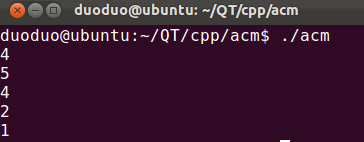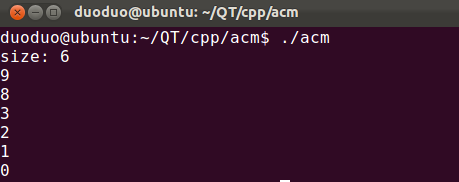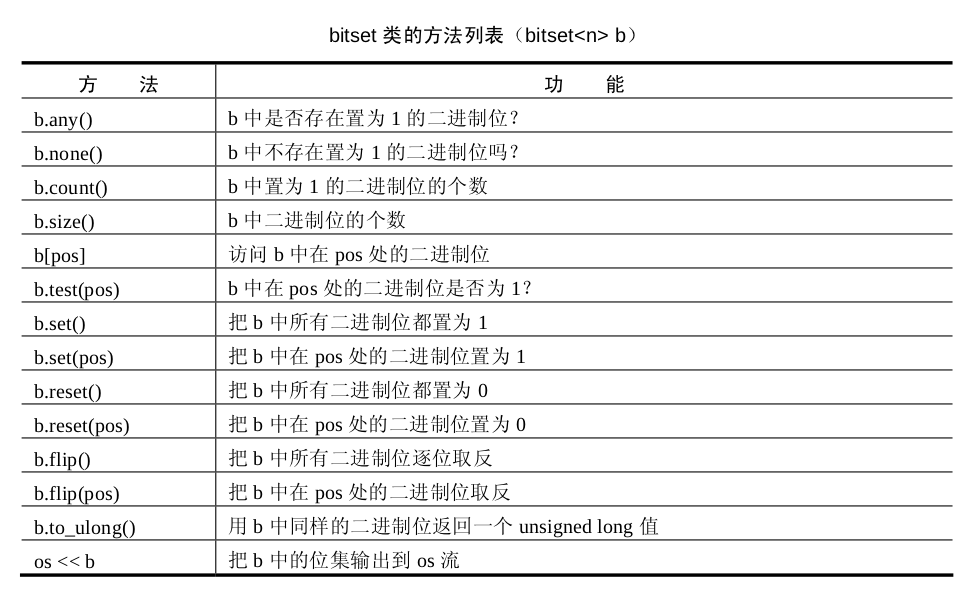迭代器(iterator)
个人理解就是把所有和迭代有关的东西给抽象出来的,不管是数组的下标,指针,for里面的、list里面的、vector里面的,抽象一下变成了iterator
#include <iostream>
#include <vector>
using namespace std;
int main()
{
vector<int> v;
for(int i = 0; i < 10; ++i )
{
v.push_back(i);
}
for(vector<int>::iterator it = v.begin(); it != v.end(); ++it)
{
cout << *it << " ";
}
cout << endl;
return 0;
}

求和(<numeric> accumulate)
accumulate(v.begin(),v.end(),0),把从 v.begin() 开始到 v.end()结束所有的元素加到 0上面去
#include <iostream>
#include <vector>
#include <numeric>
using namespace std;
int main()
{
vector<int> v;
for(int i = 0; i < 10; ++i )
{
v.push_back(i);
}
for(vector<int>::iterator it = v.begin(); it != v.end(); ++it)
{
cout << *it << " ";
}
cout << endl;
cout << accumulate(v.begin(),v.end(),0) << endl;
return 0;
}
vector(动态数组)
vector有内存管理的机制,也就是说对于插入和删除,vector可以动态调整所占用的内存空间。
vector相关函数
#include <iostream>
#include <vector>
using namespace std;
int main()
{
vector<int> v;
v.push_back(3); //数组尾部插入3
v.push_back(2);
v.push_back(1);
v.push_back(0);
cout << " 下标 " << v[3] << endl;
cout << " 迭代器 " << endl;
for(vector<int>::iterator i = v.begin();i!= v.end();++i)
{
cout << *i << " ";
}
cout << endl;
//在第一个元素之前插入111 insert begin+n是在第n个元素之前插入
v.insert(v.begin(),111);
//在最后一个元素之后插入222 insert end + n 是在n个元素之后插入
v.insert(v.end(),222);
for(vector<int>::iterator i = v.begin();i!= v.end();++i)
{
cout << *i << " ";
}
cout << endl;
vector<int> arr(10);
for(int i = 0; i < 10; i++)
{
arr[i] = i;
}
for(vector<int>::iterator i = arr.begin();i!= arr.end();++i)
{
cout << *i << " ";
}
cout << endl;
//删除 同insert
arr.erase(arr.begin());
for(vector<int>::iterator i = arr.begin();i!= arr.end();++i)
{
cout << *i << " " ;
}
cout << endl ;
arr.erase(arr.begin(),arr.begin()+5);
for(vector<int>::iterator i = arr.begin();i!= arr.end();++i)
{
cout << *i << " " ;
}
cout << endl ;
return 0 ;
}
数组转置 (<algorithm> reverse)
reverse(v.begin(),v.end())
#include<iostream>
#include<vector>
#include<algorithm>
using namespace std;
int main()
{
vector<int> v;
for(int i = 0; i < 10; ++i)
{
v.push_back(i);
}
for(vector<int>::iterator it = v.begin(); it != v.end(); ++it)
{
cout << *it << " ";
}
cout << endl;
reverse(v.begin(),v.end());
for(vector<int>::iterator it = v.begin(); it != v.end(); ++it)
{
cout << *it << " ";
}
cout << endl;
return 0;
}
<p style="margin: 10px auto; line-height: 19px; font-size: 13px; font-family: Verdana, Geneva, Arial, Helvetica, sans-serif;"><span style="background-color: rgb(255, 255, 255);"> <strong><span style="color: rgb(128, 0, 0);">排序(<algorithm> sort)</span></strong>
</span></p><p style="margin: 10px auto; line-height: 19px; font-size: 13px; font-family: Verdana, Geneva, Arial, Helvetica, sans-serif;"><span style="background-color: rgb(255, 255, 255);"> sort(v.begin(),v.end())</span></p><pre name="code" class="cpp">#include<iostream>
#include<vector>
#include<algorithm>
using namespace std;
bool Comp(const int &a,const int &b)
{
return a>b;
}
int main()
{
vector<int> v;
v.push_back(1);
v.push_back(3);
v.push_back(2);
v.push_back(55);
v.push_back(-1);
v.push_back(0);
v.push_back(2);
v.push_back(3);
v.push_back(4);
for(vector<int>::iterator it = v.begin(); it != v.end(); ++it)
{
cout << *it << " ";
}
cout << endl;
//默认升序
sort(v.begin(),v.end());
for(vector<int>::iterator it = v.begin(); it != v.end(); ++it)
{
cout << *it << " ";
}
cout << endl;
//用降序 需要自定义一个降序函数
sort(v.begin(),v.end(),Comp);
for(vector<int>::iterator it = v.begin(); it != v.end(); ++it)
{
cout << *it << " ";
}
cout << endl;
return 0;
}字符串(<string>)
输入
#include<iostream>
#include<string>
#include<cstdio>
using namespace std;
int main()
{
string s1;
s1 = "hello";
string s2;
char s[1024];
//scanf 输入速度比cin快的多
//scanf 是C函数,不可以输入string
scanf("%s",s);
s2 = s;
cout << s1 << endl;
cout << s2 << endl;
return 0;
}
尾部添加字符字符串直接用+号 例如: s += 'a'; s += "abc",或者使用append方法,s.append(“123”)
删除 (erase clear)
s.erase(it + 1,it + 4); clear()
#include<iostream>
#include<string>
using namespace std;
int main()
{
string s;
s = "0123456789";
cout << s << endl;
string::iterator it = s.begin();
//删除s[3]
s.erase(it+3);
cout << s << endl;
//删除s[1]~s[3]
s = "0123456789";
s.erase(it + 1,it + 4);
cout << s << endl;
//全部删除
s.clear();
cout << "clear : " << s << endl;
return 0;
}
查找(find)
用find找到string里面第一个要找到元素(char或者串),找到返回数组下标,找不到返回end()迭代器
string和vector有很多相同的东西,比如length(),size(),empty(),reverse(),相对也容易,就不一一说了。
数字化处理(string)
经常会遇到这样一种情况,有一个数字,需要把每一位给提取出来,如果用取余数的方法,花费的时间就会很长,所以可以当成字符串来处理,方便、省时。
例子:求一个整数各位数的和
#include<iostream>
#include<string>
using namespace std;
int main()
{
string s;
s = "123456789";
int sum = 0;
for(int i = 0; i < s.size(); ++i)
{
switch(s[i])
{
case '1': sum += 1;break;
case '2': sum += 2;break;
case '3': sum += 3;break;
case '4': sum += 4;break;
case '5': sum += 5;break;
case '6': sum += 6;break;
case '7': sum += 7;break;
case '8': sum += 8;break;
case '9': sum += 9;break;
}
}
cout << sum << endl;
return 0;
}#include<iostream>
#include<string>
#include<cstdio>
using namespace std;
int main()
{
string s_string;
char s_char[1000];
scanf("%s",s_char);
s_string = s_char;
//printf输出char* 时用c_str处理
printf(s_string.c_str());
cout << endl;
printf("%s",s_char);
cout << endl;
cout << s_char << endl;
cout << s_string << endl;
return 0;
}sscanf
#include<iostream>
#include<string>
#include<cstdio>
using namespace std;
int main()
{
string s1,s2,s3;
char sa[100],sb[100],sc[100];
sscanf("abc 123 wcd","%s%s%s",sa,sb,sc);
s1 = sa;
s2 = sb;
s3 = sc;
cout << s1 << " " << s2 << " " << s3 << endl;
//将字符串分离成数字,分隔符为',''$'
int a,b,c;
sscanf("4,5$6","%d,%d$%d",&a,&b,&c);
cout << a << " " << b << " " << c << endl;
return 0;
}
string与数值相互转换( sprintf <sstream> )
#include<iostream>
#include<string>
#include<sstream>
#include<cstdio>
using namespace std;
//c++ 方法 把数转换为string
string converToString(double x)
{
ostringstream o;
if( o << x)
{
// str()没有'\0' c_str有
return o.str();
}
return "error";
}
double converFromString(const string &s)
{
istringstream i(s);
double x;
if( i >> x)
{
return x;
}
//if error
return 0.0;
}
int main()
{
char b[100];
string s1;
//c语言方法
sprintf(b,"%d",1987);
s1 = b;
cout << s1 << endl;
string s2 = converToString(1954);
cout << s2 << endl;
string s3 = "202";
int c = converFromString(s3);
cout << c << endl;
string s4 = "casacsa6";
int d = converFromString(s4);
cout << d << endl;
string s5 = "21abf4";
int f = converFromString(s5);
cout << f << endl;
return 0;
}set容器
set是用红黑树的平衡二叉索引树的数据结构来实现的,插入时,它会自动调节二叉树排列,把元素放到适合的位置,确保每个子树根节点的键值大于左子树所有的值、小于右子树所有的值,插入重复数据时会忽略。set迭代器采用中序遍历,检索效率高于vector、deque、list,并且会将元素按照升序的序列遍历。set容器中的数值,一经更改,set会根据新值旋转二叉树,以保证平衡,构建set就是为了快速检索(python中的set一旦建立就是一个常量,不能改的)。
multiset,与set不同之处就是它允许有重复的键值。
正反遍历,迭代器iterator、reverse_iterator
#include<iostream>
#include<set>
using namespace std;
struct Comp
{
//重载()
bool operator()(const int &a, const int &b)
{
return a > b;
}
};
int main()
{
set<int,Comp> v;
v.insert(1);
v.insert(3);
v.insert(5);
v.insert(2);
v.insert(4);
v.insert(3);
for(set<int,Comp>::iterator it = v.begin(); it != v.end(); ++it)
{
cout << *it << " ";
}
cout << endl;
for(set<int,Comp>::reverse_iterator rit = v.rbegin(); rit != v.rend(); ++rit)
{
cout << *rit << " ";
}
cout << endl;
return 0;
}
2、元素本身就是结构体,直接把比较函数写在结构体内部,下面的例子依然降序:
#include<iostream>
#include<set>
#include<string>
using namespace std;
struct Info
{
string name;
double score;
//重载 <
bool operator < (const Info &a) const
{
return a.score < score;
}
};
int main()
{
set<Info> s;
Info info;
info.name = "abc";
info.score = 123.3;
s.insert(info);
info.name = "EDF";
info.score = -23.53;
s.insert(info);
info.name = "xyz";
info.score = 73.3;
s.insert(info);
for(set<Info>::iterator it = s.begin(); it != s.end(); ++it)
{
cout << (*it).name << ":" << (*it).score << endl;
}
cout << endl;
for(set<Info>::reverse_iterator rit = s.rbegin(); rit != s.rend(); ++rit)
{
cout << (*rit).name << ":" << (*rit).score << endl;
}
cout << endl;
return 0;
}
multiset与set的不同之处就是key可以重复,以及erase(key)的时候会删除multiset里面所有的key并且返回删除的个数。
map
map也是使用红黑树,他是一个键值对(key:value映射),便利时依然默认按照key程序的方式遍历,同set。
#include<iostream>
#include<map>
#include<string>
using namespace std;
int main()
{
map<string,double> m;
//声明即插入
m["li"] = 123.4;
m["wang"] = 23.1;
m["zhang"] = -21.9;
m["abc"] = 12.1;
for(map<string,double>::iterator it = m.begin(); it != m.end(); ++it)
{
//first --> key second --> value
cout << (*it).first << ":" << (*it).second << endl;
}
cout << endl;
return 0;
}
用map实现数字分离
string --> number
之前用string进行过数字分离,现在使用map
#include<iostream>
#include<map>
#include<string>
using namespace std;
int main()
{
map<char,int> m;
m['0'] = 0;
m['1'] = 1;
m['2'] = 2;
m['3'] = 3;
m['4'] = 4;
m['5'] = 5;
m['6'] = 6;
m['7'] = 7;
m['8'] = 8;
m['9'] = 9;
/*
等价于
for(int i = 0; i < 10; ++i)
{
m['0' + i] = i;
}
*/
string sa;
sa = "9876543210";
int sum = 0;
for( int i = 0; i < sa.length(); ++i)
{
sum += m[sa[i]];
}
cout << sum << endl;
return 0;
}用map实现数字分离
string --> number
之前用string进行过数字分离,现在使用map
#include<iostream>
#include<map>
#include<string>
using namespace std;
int main()
{
map<char,int> m;
m['0'] = 0;
m['1'] = 1;
m['2'] = 2;
m['3'] = 3;
m['4'] = 4;
m['5'] = 5;
m['6'] = 6;
m['7'] = 7;
m['8'] = 8;
m['9'] = 9;
/*
等价于
for(int i = 0; i < 10; ++i)
{
m['0' + i] = i;
}
*/
string sa;
sa = "9876543210";
int sum = 0;
for( int i = 0; i < sa.length(); ++i)
{
sum += m[sa[i]];
}
cout << sum << endl;
return 0;
}
deque
deque和vector一样,采用线性表,与vector唯一不同的是,deque采用的分块的线性存储结构,每块大小一般为512字节,称为一个deque块,所有的deque块使用一个Map块进行管理,每个map数据项记录各个deque块的首地址,这样以来,deque块在头部和尾部都可已插入和删除元素,而不需要移动其它元素。使用push_back()方法在尾部插入元素,使用push_front()方法在首部插入元素,使用insert()方法在中间插入元素。一般来说,当考虑容器元素的内存分配策略和操作的性能时,deque相对vectore更有优势。(下面这个图,我感觉Map块就是一个list< map<deque名字,deque地址> >)

插入删除
遍历当然可以使用下标遍历,在这里使用迭代器。
#include <iostream>
#include <deque>
using namespace std;
int main()
{
deque<int> d;
//尾部插入
d.push_back(1);
d.push_back(3);
d.push_back(2);
for(deque<int>::iterator it = d.begin(); it != d.end(); ++it )
{
cout << (*it) << " ";
}
cout << endl << endl;
//头部插入
d.push_front(10);
d.push_front(-23);
for(deque<int>::iterator it = d.begin(); it != d.end(); ++it )
{
cout << (*it) << " ";
}
cout << endl << endl;
d.insert(d.begin() + 2,9999);
for(deque<int>::iterator it = d.begin(); it != d.end(); ++it )
{
cout << (*it) << " ";
}
cout << endl << endl;
//反方向遍历
for(deque<int>::reverse_iterator rit = d.rbegin(); rit != d.rend(); ++rit )
{
cout << (*rit) << " ";
}
cout << endl << endl;
//删除元素pop pop_front从头部删除元素 pop_back从尾部删除元素 erase中间删除 clear全删
d.clear();
d.push_back(1);
d.push_back(2);
d.push_back(3);
d.push_back(4);
d.push_back(5);
d.push_back(6);
d.push_back(7);
d.push_back(8);
for(deque<int>::iterator it = d.begin(); it != d.end(); ++it )
{
cout << (*it) << " ";
}
cout << endl;
d.pop_front();
d.pop_front();
for(deque<int>::iterator it = d.begin(); it != d.end(); ++it )
{
cout << (*it) << " ";
}
cout << endl;
d.pop_back();
d.pop_back();
for(deque<int>::iterator it = d.begin(); it != d.end(); ++it )
{
cout << (*it) << " ";
}
cout << endl;
d.erase(d.begin() + 1);
for(deque<int>::iterator it = d.begin(); it != d.end(); ++it )
{
cout << (*it) << " ";
}
cout << endl;
return 0;
}list
list<int> l
插入:push_back尾部,push_front头部,insert方法前往迭代器位置处插入元素,链表自动扩张,迭代器只能使用++--操作,不能用+n -n,因为元素不是物理相连的。
遍历:iterator和reverse_iterator正反遍历
删除:pop_front删除链表首元素;pop_back()删除链表尾部元素;erase(迭代器)删除迭代器位置的元素,注意只能使用++--到达想删除的位置;remove(key) 删除链表中所有key的元素,clear()清空链表。
查找:it = find(l.begin(),l.end(),key)
排序:l.sort()
删除连续重复元素:l.unique() 【2 8 1 1 1 5 1】 --> 【 2 8 1 5 1】
bitset
从来没用过,上两幅图吧就:

stack(后进先出)
这个印象深刻,学数据结构的时候做表达式求值的就是用的栈。

#include <iostream>
#include <stack>
using namespace std;
int main()
{
stack<int> s;
s.push(1);
s.push(2);
s.push(4);
s.push(5);
cout << s.size() << endl;
while(s.empty() != true)
{
cout << s.top() << endl;
s.pop();
}
return 0;
}
stack然我唯一费解之处在于,貌似它没有iterator,可以试试s.begin()编译器报错的。
queue(先进先出)

queue有入队push(插入)、出队pop(删除)、读取队首元素front、读取队尾元素back、empty,size这几种方法
priority_queue(最大元素先出)


#include <iostream>
#include <queue>
using namespace std;
int main()
{
priority_queue<int> pq;
pq.push(1);
pq.push(3);
pq.push(2);
pq.push(8);
pq.push(9);
pq.push(0);
cout << "size: " << pq.size() << endl;
while(pq.empty() != true)
{
cout << pq.top() << endl;
pq.pop();
}
return 0;
}
重载操作符同set重载操作符。
我不是代码的原创者,我只是代码的搬运工。
原文地址:http://www.cnblogs.com/duoduo369/archive/2012/04/12/2439118.html


























 533
533

 被折叠的 条评论
为什么被折叠?
被折叠的 条评论
为什么被折叠?








